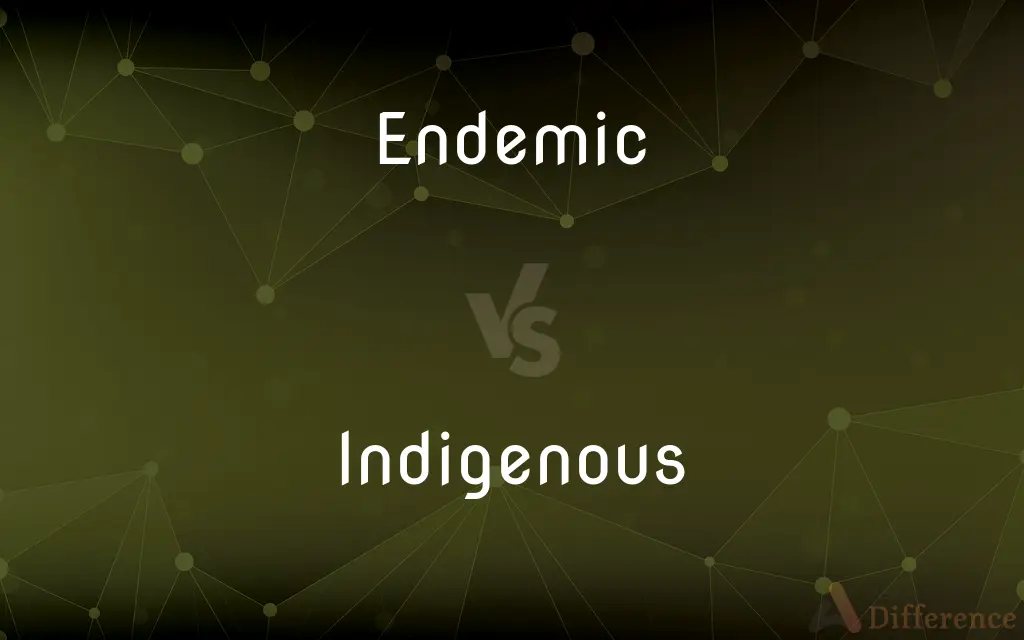Endemic vs. Indigenous — What's the Difference?
By Tayyaba Rehman & Maham Liaqat — Updated on May 2, 2024
Endemic refers to species native to a specific region, exclusively found there, while indigenous pertains to species or peoples originating and living naturally in an area, not necessarily exclusive to that location.

Difference Between Endemic and Indigenous
Table of Contents
ADVERTISEMENT
Key Differences
An endemic species is one that is found only in a specific geographical area and nowhere else on Earth, often isolated by natural boundaries that prevent it from spreading. Indigenous species, however, are native to a particular region or environment but can also be found in other areas that share similar conditions.
Endemic species are often highlighted in conservation efforts due to their limited distribution, which makes them particularly susceptible to extinction. Indigenous species, while also a focus for conservation, generally have a wider range and adaptability, which might afford them slightly better resilience against threats.
For example, the lemurs of Madagascar are considered endemic because they exist nowhere else but on that island. In contrast, the gray wolf is indigenous to North America but is also found in Europe and Asia, demonstrating a broader natural distribution.
The concept of endemism can apply to plants, animals, fungi, and even diseases that are restricted to a specific location due to unique environmental conditions or evolutionary history. Indigenous species encompass a broader category, including any organisms that originate and thrive in an area without human intervention.
Both terms emphasize a natural occurrence and origin, but "endemic" carries a stricter implication of exclusivity compared to "indigenous," which pertains more to origin than exclusive localization.
ADVERTISEMENT
Comparison Chart
Definition
Species exclusively native to a specific area
Species originating and living naturally in an area
Distribution
Very limited, specific locale
Can be broader, multiple regions
Conservation Focus
High due to vulnerability from limited distribution
Generally broad but depends on ecological value
Example
Lemurs of Madagascar (only found there)
Gray wolf (North America, Europe, Asia)
Application
Often used in ecological and conservation contexts
Used broadly in ecological, cultural contexts
Compare with Definitions
Endemic
A condition of being unique to a defined region or environment in terms of occurrence.
The disease is endemic to tropical areas.
Indigenous
Applies to human populations whose historical ties to a region are long-standing.
The Sami people are indigenous to Scandinavia.
Endemic
Relating to a species exclusively found in a specified geographic location.
The Galápagos tortoise is endemic to the Galápagos Islands.
Indigenous
Pertaining to species or peoples originating in and characteristic of a particular region.
Corn is indigenous to the Americas.
Endemic
Indicates a natural distribution limited by geographical boundaries.
The kangaroo is endemic to Australia.
Indigenous
Reflects a broad natural adaptation and presence across similar ecosystems.
Birch trees are indigenous to Northern Hemisphere forests.
Endemic
Pertains to ecological uniqueness and isolation.
Endemic species often face higher risks of extinction.
Indigenous
Concerns both ecological and cultural aspects of nativity.
Indigenous knowledge is crucial for local ecosystem management.
Endemic
Used to describe organisms that are not found naturally anywhere else.
Many plants in Hawaii are endemic, evolving in isolation.
Indigenous
Often used to describe native plants and animals that are naturally occurring.
The American bison is indigenous to the plains of North America.
Endemic
Prevalent in a particular locality, region, or population
Endemic diseases of the tropics.
Indigenous
Originating or occurring naturally in a particular place; native
The indigenous peoples of Siberia
Coriander is indigenous to southern Europe
Endemic
Native only to a particular locality or region
Endemic birds.
Indigenous
Originating, growing, or produced in a certain place or region.
Endemic
Common in or inherent to an enterprise or situation
"All the difficulties endemic to historical research become more acute in the case of war" (Constantine Pleshakov).
Indigenous
Being a member of the original inhabitants of a particular place.
Endemic
An organism that is native only to a particular locality or region.
Indigenous
Of, belonging to, or characteristic of such inhabitants.
Endemic
A disease that is prevalent in a particular locality, region, or population.
Indigenous
Born or originating in, native to a land or region, especially before an intrusion.
Endemic
Native to a particular area or culture; originating where it occurs.
The endemic religion of Easter Island arrived with the Polynesian settlers.
Indigenous
In particular, of or relating to a people (or their language or culture) that inhabited a region prior to the arrival of people of other cultures which became dominant (e.g., through colonialism), and which maintains a distinct culture.
The Ainu are the indigenous ethnic group of Japan's Hokkaido Island.
Endemic
(especially of plants and animals) Peculiar to a particular area or region; not found in other places.
Kangaroos are endemic to Australia.
Indigenous
Innate, inborn.
Endemic
(especially of diseases) Prevalent in a particular area or region.
Malaria is endemic to the tropics.
Indigenous
Native; produced, growing, or living, naturally in a country or climate; not exotic; not imported.
Negroes were all transported from Africa and are not indigenous or proper natives of America.
In America, cotton, being indigenous, is cheap.
Endemic
An individual or species that is endemic to a region.
Indigenous
Native; inherent; innate.
Joy and hope are emotions indigenous to the human mind.
Endemic
A disease affecting a number of people simultaneously, so as to show a distinct connection with certain localities.
Indigenous
Originating where it is found;
The autochthonal fauna of Australia includes the kangaroo
Autochthonous rocks and people and folktales
Endemic folkways
The Ainu are indigenous to the northernmost islands of Japan
Endemic
Peculiar to a district or particular locality, or class of persons; as, an endemic disease.
Endemic
Belonging or native to a particular people or country; native as distinguished from introduced or naturalized; hence, regularly or ordinarily occurring in a given region; local; as, a plant endemic in Australia; - often distinguished from exotic.
The traditions of folklore . . . form a kind of endemic symbolism.
Endemic
An endemic disease.
Fear, which is an endemic latent in every human heart, sometimes rises into an epidemic.
Endemic
A disease that is constantly present to a greater or lesser degree in people of a certain class or in people living in a particular location
Endemic
A plant that is native to a certain limited area;
It is an endemic found only this island
Endemic
Of or relating to a disease (or anything resembling a disease) constantly present to greater or lesser extent in a particular locality;
Diseases endemic to the tropics
Endemic malaria
Food shortages and starvation are endemic in certain parts of the world
An epidemic outbreak of influenza
Endemic
Native to or confined to a certain region;
The islands have a number of interesting endemic species
Endemic
Originating where it is found;
The autochthonal fauna of Australia includes the kangaroo
Autochthonous rocks and people and folktales
Endemic folkways
The Ainu are indigenous to the northernmost islands of Japan
Common Curiosities
Can a species be both indigenous and endemic?
Yes, a species can be both if it originates from and is confined to a particular location.
What impact does human activity have on endemic species?
Human activities such as habitat destruction, pollution, and introduction of invasive species can severely impact endemic species due to their limited adaptability and small geographic range.
How are indigenous species identified?
Indigenous species are identified through historical records, ecological studies, and genetic analyses that demonstrate their long-standing presence and adaptation to a specific region.
Are there cultural implications associated with indigenous species?
Yes, many indigenous species hold significant cultural, spiritual, and economic importance for local communities.
Why is the conservation of endemic species important?
Endemic species often have very limited distributions, making them highly vulnerable to extinction due to habitat loss or changes in their environment.
How do endemic and indigenous species differ in their vulnerability?
Endemic species, due to their restricted range, are usually more vulnerable to threats than indigenous species, which may have a broader and more adaptable range.
What does it mean for a species to be endemic?
A species is considered endemic when it is found only in a specific, often isolated geographic area and nowhere else in the world.
What role do indigenous species play in their ecosystems?
Indigenous species play crucial roles in maintaining the ecological balance, contributing to the structure and function of their habitats.
What challenges do conservationists face when dealing with endemic species?
Challenges include limited genetic diversity, restricted habitats, and sensitivity to ecological changes, making conservation efforts complex.
How does globalization affect indigenous species?
Globalization can lead to habitat loss, spread of diseases, and introduction of invasive species, threatening indigenous species.
What is an example of an indigenous species?
The gray wolf, which is indigenous to several continents including North America and Asia, is a good example.
What measures are taken to protect endemic species?
Measures to protect endemic species include habitat preservation, legal protection, conservation breeding programs, and ecological restoration.
Why might an indigenous species be less threatened than an endemic one?
Indigenous species, because of their presence in multiple regions, may have more genetic diversity and adaptability, reducing their overall vulnerability.
What is a real-world example of an endangered endemic species?
The Hawaiian monk seal is an endangered endemic species, facing threats from human encroachment and environmental changes.
Can endemic species become invasive elsewhere?
It’s rare, but if moved out of their native context, endemic species can become invasive if they adapt to and dominate the new environment.
Share Your Discovery

Previous Comparison
Labourer vs. Laborer
Next Comparison
Dialect vs. DialogueAuthor Spotlight
Written by
Tayyaba RehmanTayyaba Rehman is a distinguished writer, currently serving as a primary contributor to askdifference.com. As a researcher in semantics and etymology, Tayyaba's passion for the complexity of languages and their distinctions has found a perfect home on the platform. Tayyaba delves into the intricacies of language, distinguishing between commonly confused words and phrases, thereby providing clarity for readers worldwide.
Co-written by
Maham Liaqat















































